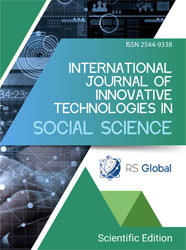THE IMPACT OF PHYSICAL ACTIVITY ON METABOLIC SYNDROME AND CARDIOVASCULAR RISK
Abstract
Background: Metabolic syndrome (MetS) is one of the most serious public-health challenges, affecting approximately 25 % of the adult population worldwide and more than doubling the risk of cardiovascular disease (CVD). It is characterised by the coexistence of abdominal obesity, insulin resistance, dyslipidemia and arterial hypertension, which translates into markedly increased mortality risk. Physical activity (PA) has been identified as a key modifiable factor in the prevention and treatment of this cluster of disorders. The aim of this review is to discuss in detail the impact of various forms of PA on the components of MetS and on CVD risk.
Methods and Materials: A systematic review of the scientific literature was carried out, analysing randomised trials, meta-analyses and observational studies that assessed the effectiveness of aerobic, resistance and high-intensity interval training.
Conclusions: Regular PA exerts a multidirectional influence on all components of MetS, effectively reducing abdominal obesity, insulin resistance, dyslipidemia and hypertension. Aerobic training shows the greatest efficacy in improving metabolic parameters, whereas the combination of aerobic and resistance modalities provides the most favourable therapeutic outcomes. In secondary prevention of CVD, PA achieves effectiveness comparable to pharmacotherapy and significantly surpasses it in post-stroke patients. The underlying mechanisms include improvements in insulin sensitivity, enhanced glucose uptake by skeletal muscle, and beneficial modulation of adipokine and cytokine profiles. The review underlines the importance of regular PA as a public-health strategy and highlights the need for further research aimed at optimising intervention programs.
References
Dobrowolski P, Prejbisz A, Kuryłowicz A, et al. Metabolic syndrome — a new definition and management guidelines. Arterial Hypertension. 2022;26(3):99-121. doi:10.5603/AH.a2022.0012
Saklayen MG. The Global Epidemic of the Metabolic Syndrome. Current Hypertension Reports. 2018;20(2):12. doi:10.1007/s11906-018-0812-z
Mottillo Salvatore, Filion Kristian B., Genest Jacques, et al. The Metabolic Syndrome and Cardiovascular Risk. JACC. 2010;56(14):1113-1132. doi:10.1016/j.jacc.2010.05.034
Riley L, Guthold R, Cowan M, et al. The World Health Organization STEPwise Approach to Noncommunicable Disease Risk-Factor Surveillance: Methods, Challenges, and Opportunities. Am J Public Health. 2016;106(1):74-78. doi:10.2105/AJPH.2015.302962
Hirode G, Wong RJ. Trends in the Prevalence of Metabolic Syndrome in the United States, 2011-2016. JAMA. 2020;323(24):2526-2528. doi:10.1001/jama.2020.4501
World Health Organization (2024). Physical activity. Available at: https://www.who.int/news-room/fact-sheets/detail/physical-activity
Codazzi V, Frontino G, Galimberti L, Giustina A, Petrelli A. Mechanisms and risk factors of metabolic syndrome in children and adolescents. Endocrine. 2024;84(1):16-28. doi:10.1007/s12020-023-03642-x
Chung YL, Rhie YJ. Metabolic Syndrome in Children and Adolescents. Ewha Med J. 2022;45(4). doi:10.12771/emj.2022.e13
Chukwuemeka UM, Chukwu PO, Anakor AC, Ukachi PN, Ayara D, Maruf FA. Prevalence of metabolic syndrome and its associations with stress and physical activity levels: a cross-sectional study involving university staff in Nigeria. Bulletin of Faculty of Physical Therapy. 2025;30(1):28. doi:10.1186/s43161-025-00287-x
Buchmann N, Eckstein N, Spira D, Demuth I, Steinhagen-Thiessen E, Norman K. Vitamin D insufficiency is associated with metabolic syndrome independent of insulin resistance and obesity in young adults - The Berlin Aging Study II. Diabetes Metab Res Rev. 2021;37(8):e3457. doi:10.1002/dmrr.3457
Jansen EC, Burgess HJ, Chervin RD, et al. Sleep duration and timing are prospectively linked with insulin resistance during late adolescence. Obesity (Silver Spring). 2023;31(4):912-922. doi:10.1002/oby.23680
Liang M, Pan Y, Zhong T, Zeng Y, Cheng ASK. Effects of aerobic, resistance, and combined exercise on metabolic syndrome parameters and cardiovascular risk factors: a systematic review and network meta-analysis. Rev Cardiovasc Med. 2021;22(4):1523-1533. doi:10.31083/j.rcm2204156
Shariful Islam M, Fardousi A, Sizear MI, Rabbani MG, Islam R, Saif-Ur-Rahman KM. Effect of leisure-time physical activity on blood pressure in people with hypertension: a systematic review and meta-analysis. Sci Rep. 2023;13(1):10639. doi:10.1038/s41598-023-37149-2
Myers J, Kokkinos P, Nyelin E. Physical Activity, Cardiorespiratory Fitness, and the Metabolic Syndrome. Nutrients. 2019;11(7):1652. doi:10.3390/nu11071652
Nishii K, Aizu N, Yamada K. Review of the health-promoting effects of exercise and the involvement of myokines. Fujita Med J. 2023;9(3):171-178. doi:10.20407/fmj.2022-020
Simioni C, Zauli G, Martelli AM, et al. Oxidative stress: role of physical exercise and antioxidant nutraceuticals in adulthood and aging. Oncotarget. 2018;9(24):17181-17198. doi:10.18632/oncotarget.24729
Weiss EP, Jordan RC, Frese EM, Albert SG, Villareal DT. Effects of Weight Loss on Lean Mass, Strength, Bone, and Aerobic Capacity. Med Sci Sports Exerc. 2017;49(1):206-217. doi:10.1249/MSS.0000000000001074
Ellulu MS, Patimah I, Khaza’ai H, Rahmat A, Abed Y. Obesity and inflammation: the linking mechanism and the complications. Arch Med Sci. 2017;13(4):851-863. doi:10.5114/aoms.2016.58928
Lemieux I, Després JP. Metabolic Syndrome: Past, Present and Future. Nutrients. 2020;12(11):3501. doi:10.3390/nu12113501
Lagacé J, Marcotte‐Chenard A, Paquin J, Tremblay D, Brochu M, Dionne IJ. Increased odds of having the metabolic syndrome with greater fat‐free mass: counterintuitive results from the National Health and Nutrition Examination Survey database. J Cachexia Sarcopenia Muscle. 2022;13(1):377-385. doi:10.1002/jcsm.12856
Chomiuk T, Niezgoda N, Mamcarz A, Śliż D. Physical activity in metabolic syndrome. Front Physiol. 2024;15:1365761. doi:10.3389/fphys.2024.1365761
Golbidi S, Mesdaghinia A, Laher I. Exercise in the Metabolic Syndrome. Oxid Med Cell Longev. 2012;2012:349710. doi:10.1155/2012/349710
Shih KC, Kwok CF. Exercise reduces body fat and improves insulin sensitivity and pancreatic β-cell function in overweight and obese male Taiwanese adolescents. BMC Pediatr. 2018;18:80. doi:10.1186/s12887-018-1025-y
Little JP, Safdar A, Benton CR, Wright DC. Skeletal muscle and beyond: the role of exercise as a mediator of systemic mitochondrial biogenesis. Appl Physiol Nutr Metab. 2011;36(5):598-607. doi:10.1139/h11-076
Ostman C, Smart NA, Morcos D, Duller A, Ridley W, Jewiss D. The effect of exercise training on clinical outcomes in patients with the metabolic syndrome: a systematic review and meta-analysis. Cardiovasc Diabetol. 2017;16(1):110. doi:10.1186/s12933-017-0590-y
Yaribeygi H, Maleki M, Sathyapalan T, Jamialahmadi T, Sahebkar A. Pathophysiology of Physical Inactivity-Dependent Insulin Resistance: A Theoretical Mechanistic Review Emphasizing Clinical Evidence. J Diabetes Res. 2021;2021:7796727. doi:10.1155/2021/7796727
Strasser B. Physical activity in obesity and metabolic syndrome. Ann N Y Acad Sci. 2013;1281(1):141-159. doi:10.1111/j.1749-6632.2012.06785.x
Crichton GE, Alkerwi A. Physical activity, sedentary behavior time and lipid levels in the Observation of Cardiovascular Risk Factors in Luxembourg study. Lipids Health Dis. 2015;14:87. doi:10.1186/s12944-015-0085-3
Königstein K, Dipla K, Zafeiridis A. Training the Vessels: Molecular and Clinical Effects of Exercise on Vascular Health—A Narrative Review. Cells. 2023;12(21):2544. doi:10.3390/cells12212544
Ostman C, Smart NA, Morcos D, Duller A, Ridley W, Jewiss D. The effect of exercise training on clinical outcomes in patients with the metabolic syndrome: a systematic review and meta-analysis. Cardiovasc Diabetol. 2017;16:110. doi:10.1186/s12933-017-0590-y
Ettehad D, Emdin CA, Kiran A, et al. Blood pressure lowering for prevention of cardiovascular disease and death: a systematic review and meta-analysis. Lancet. 2016;387(10022):957-967. doi:10.1016/S0140-6736(15)01225-8
Mendelson M, Michallet AS, Monneret D, et al. Impact of exercise training without caloric restriction on inflammation, insulin resistance and visceral fat mass in obese adolescents. Pediatr Obes. 2015;10(4):311-319. doi:10.1111/ijpo.255
Whooten R, Kerem L, Stanley T. Physical Activity in Adolescents and Children and Relationship to Metabolic Health. Curr Opin Endocrinol Diabetes Obes. 2019;26(1):25-31. doi:10.1097/MED.0000000000000455
Soares-Miranda L, Siscovick DS, Psaty BM, Longstreth WT, Mozaffarian D. Physical Activity and Risk of Coronary Heart Disease and Stroke in Older Adults. Circulation. 2016;133(2):147-155. doi:10.1161/CIRCULATIONAHA.115.018323
Bateman LA, Slentz CA, Willis LH, et al. Comparison of Aerobic Versus Resistance Exercise Training Effects on Metabolic Syndrome (from the Studies of a Targeted Risk Reduction Intervention Through Defined Exercise - STRRIDE-AT/RT). American Journal of Cardiology. 2011;108(6):838-844. doi:10.1016/j.amjcard.2011.04.037
Stensvold D, Slørdahl SA, Wisløff U. Effect of exercise training on inflammation status among people with metabolic syndrome. Metab Syndr Relat Disord. 2012;10(4):267-272. doi:10.1089/met.2011.0140
Motahari-Tabari N, Ahmad Shirvani M, Shirzad-E-Ahoodashty M, Yousefi-Abdolmaleki E, Teimourzadeh M. The effect of 8 weeks aerobic exercise on insulin resistance in type 2 diabetes: a randomized clinical trial. Glob J Health Sci. 2014;7(1):115-121. doi:10.5539/gjhs.v7n1p115
de Barcelos GT, Heberle I, Coneglian JC, Vieira BA, Delevatti RS, Gerage AM. Effects of Aerobic Training Progression on Blood Pressure in Individuals With Hypertension: A Systematic Review With Meta-Analysis and Meta-Regression. Front Sports Act Living. 2022;4:719063. doi:10.3389/fspor.2022.719063
Maruf FA, Akinpelu AO, Salako BL, Akinyemi JO. Effects of aerobic dance training on blood pressure in individuals with uncontrolled hypertension on two antihypertensive drugs: a randomized clinical trial. J Am Soc Hypertens. 2016;10(4):336-345. doi:10.1016/j.jash.2016.02.002
Monda V, Sessa F, Ruberto M, et al. Aerobic Exercise and Metabolic Syndrome: The Role of Sympathetic Activity and the Redox System. Diabetes Metab Syndr Obes. 2020;13:2433-2442. doi:10.2147/DMSO.S257687
Braggio M, Dorelli G, Olivato N, et al. Tailored Exercise Intervention in Metabolic Syndrome: Cardiometabolic Improvements Beyond Weight Loss and Diet—A Prospective Observational Study. Nutrients. 2025;17(5):872. doi:10.3390/nu17050872
Martin A, Fox D, Murphy CA, Hofmann H, Koehler K. Tissue losses and metabolic adaptations both contribute to the reduction in resting metabolic rate following weight loss. Int J Obes (Lond). 2022;46(6):1168-1175. doi:10.1038/s41366-022-01090-7
Kazemi SS, Heidarianpour A, Shokri E. Effect of resistance training and high-intensity interval training on metabolic parameters and serum level of Sirtuin1 in postmenopausal women with metabolic syndrome: a randomized controlled trial. Lipids Health Dis. 2023;22:177. doi:10.1186/s12944-023-01940-x
Jiahao L, Jiajin L, Yifan L. Effects of resistance training on insulin sensitivity in the elderly: A meta-analysis of randomized controlled trials. J Exerc Sci Fit. 2021;19(4):241-251. doi:10.1016/j.jesf.2021.08.002
de Sousa EC, Abrahin O, Ferreira ALL, Rodrigues RP, Alves EAC, Vieira RP. Resistance training alone reduces systolic and diastolic blood pressure in prehypertensive and hypertensive individuals: meta-analysis. Hypertens Res. 2017;40(11):927-931. doi:10.1038/hr.2017.69
Lopez P, Taaffe DR, Galvão DA, et al. Resistance training effectiveness on body composition and body weight outcomes in individuals with overweight and obesity across the lifespan: A systematic review and meta‐analysis. Obes Rev. 2022;23(5):e13428. doi:10.1111/obr.13428
Kobayashi Y, Long J, Dan S, et al. Strength training is more effective than aerobic exercise for improving glycaemic control and body composition in people with normal-weight type 2 diabetes: a randomised controlled trial. Diabetologia. 2023;66(10):1897-1907. doi:10.1007/s00125-023-05958-9
Guo Z, Li M, Cai J, Gong W, Liu Y, Liu Z. Effect of High-Intensity Interval Training vs. Moderate-Intensity Continuous Training on Fat Loss and Cardiorespiratory Fitness in the Young and Middle-Aged a Systematic Review and Meta-Analysis. Int J Environ Res Public Health. 2023;20(6):4741. doi:10.3390/ijerph20064741
Yang F, Ma Y, Liang S, Shi Y, Wang C. Effect of Exercise Modality on Heart Rate Variability in Adults: A Systematic Review and Network Meta-Analysis. RCM. 2024;25(1):9. doi:10.31083/j.rcm2501009
Dun Y, Smith JR, Liu S, Olson TP. High-Intensity Interval Training in Cardiac Rehabilitation. Clin Geriatr Med. 2019;35(4):469-487. doi:10.1016/j.cger.2019.07.011
Coates AM, Joyner MJ, Little JP, Jones AM, Gibala MJ. A Perspective on High-Intensity Interval Training for Performance and Health. Sports Med. 2023;53(Suppl 1):85-96. doi:10.1007/s40279-023-01938-6
Visseren FLJ, Mach F, Smulders YM, et al. 2021 ESC Guidelines on cardiovascular disease prevention in clinical practice: Developed by the Task Force for cardiovascular disease prevention in clinical practice with representatives of the European Society of Cardiology and 12 medical societies With the special contribution of the European Association of Preventive Cardiology (EAPC). European Heart Journal. 2021;42(34):3227-3337. doi:10.1093/eurheartj/ehab484
Joseph MS, Tincopa MA, Walden P, Jackson E, Conte ML, Rubenfire M. The Impact Of Structured Exercise Programs On Metabolic Syndrome And Its Components: A Systematic Review. Diabetes Metab Syndr Obes. 2019;12:2395-2404. doi:10.2147/DMSO.S211776
Stamatakis E, Gale J, Bauman A, Ekelund U, Hamer M, Ding D. Sitting Time, Physical Activity, and Risk of Mortality in Adults. JACC. 2019;73(16):2062-2072. doi:10.1016/j.jacc.2019.02.031
Chung N, Park MY, Kim J, et al. Non-exercise activity thermogenesis (NEAT): a component of total daily energy expenditure. J Exerc Nutrition Biochem. 2018;22(2):23-30. doi:10.20463/jenb.2018.0013
Views:
26
Downloads:
17
Copyright (c) 2025 Mikołaj Asztabski, Laura Magdalena Sikorska, Paulina Pudło, Anna Koman, Monika Czekalska, Weronika Worosz, Martyna Bukowiec, Luiza Łabuzińska, Angela Ćwil, Natalia Morawiecka, Kacper Byczek

This work is licensed under a Creative Commons Attribution 4.0 International License.
All articles are published in open-access and licensed under a Creative Commons Attribution 4.0 International License (CC BY 4.0). Hence, authors retain copyright to the content of the articles.
CC BY 4.0 License allows content to be copied, adapted, displayed, distributed, re-published or otherwise re-used for any purpose including for adaptation and commercial use provided the content is attributed.















